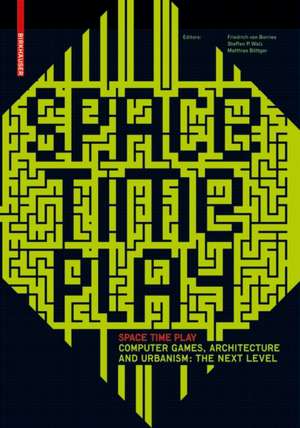Space Time Play: Computer Games, Architecture and Urbanism: The Next Level
Editat de Friedrich von Borries Drew Davidson, Heather Kelley Editat de Steffen P. Walz Julian Kücklich Editat de Matthias Böttgeren Limba Engleză Paperback – 13 sep 2007
Preț: 247.66 lei
Nou
Puncte Express: 371
Preț estimativ în valută:
47.39€ • 49.61$ • 39.21£
47.39€ • 49.61$ • 39.21£
Carte indisponibilă temporar
Doresc să fiu notificat când acest titlu va fi disponibil:
Se trimite...
Preluare comenzi: 021 569.72.76
Specificații
ISBN-13: 9783764384142
ISBN-10: 376438414X
Pagini: 496
Ilustrații: 495 p. 268 illus. in color.
Dimensiuni: 170 x 240 x 15 mm
Greutate: 1.2 kg
Ediția:2007
Editura: Birkhäuser Basel
Colecția Birkhäuser
Locul publicării:Basel, Switzerland
ISBN-10: 376438414X
Pagini: 496
Ilustrații: 495 p. 268 illus. in color.
Dimensiuni: 170 x 240 x 15 mm
Greutate: 1.2 kg
Ediția:2007
Editura: Birkhäuser Basel
Colecția Birkhäuser
Locul publicării:Basel, Switzerland
Descriere
Computer and video games are leaving the PC and conquering the arena of everyday life in the form of mobile applications (such as GPS cell phones, etc.) – the result is new types of cities and architecture. How do these games alter our perception of real and virtual space? What can the designers of physical and digital worlds learn from one another? Space Time Play presents the following themes: the superimposition of computer games on real spaces and convergences of real and imaginary playspaces; computer and video games as practical planning instruments. With articles by Espen Aarseth, Ernest Adams, Richard A. Bartle, Ian Bogost, Gerhard M. Buurman, Edward Castranova, Kees Christiaanse, Drew Davidson, James Der Derian, Noah Falstein, Stephen Graham, Ludger Hovestadt, Henry Jenkins, Heather Kelley, James Korris, Julian Kücklich, Frank Lantz, Lev Manovich, Jane McGonigal, William J. Mitchell, Kas Oosterhuis, Katie Salen, Mark Wigley, and others.
Cuprins
The Architecture of Computer and Video Games.- Places to Play.- Dance Dance Revolution.- Breakout for Two.- Wii Sports.- A Short History of Digital Gamespace.- Tennis for Two/Pong.- Asteroids.- Battlezone.- Defender.- Wolfenstein 3D.- Counter-Strike.- Allegories of Space.- Myst.- Super Mario Bros..- Tetris.- ICO.- Narrative Spaces.- Game Physics.- Zork.- Lemmings.- Worms.- Max Payne.- Charbitat.- Labyrinth and Maze.- Pac-Man.- Diablo.- Silent Hill 2.- Splinter Cell.- Sam & Max Hit the Road.- Steering Through the Microworld.- Kirby: Canvas Curse.- Katamari Damacy.- Eyetoy Play.- Variation over Time.- Elite.- Prince of Persia.- Super Mario 64.- Listen to the Bulk of the Iceberg.- Rez.- Descent.- Wallhacks and Aimbots.- Super Monkey Ball.- Tony Hawk’s American Wasteland.- Legacy of Kain: Soul Reaver.- Rescue on Fractalus.- Quake.- Form Follows FUN.- Load and Support.- Make Believe Urbanism.- Tron.- Neuromancer.- Snow Crash.- Use Your Illusion.- The Sims.- There.- Entropia Universe.- Second Life.- Making Places.- Activity Flow Architecture.- Lineage.- Kingdom Hearts.- World of Warcraft.- What Is A Synthetic World?.- Sid Meier’s Civilization.- Animal Crossing.- Competing in Metagame Gamespace.- Playing with Friends and Families.- Dark Chronicle.- The Getaway.- Grand Theft Auto: San Andreas.- Grim Fandango.- Psychonauts.- Narrative Environments.- Playing with Urban Life.- SimCity.- Majestic.- New Public Sphere.- Ubiquitous Games.- New Babylon Reloaded.- Geocaching.- Mogi.- Botfighters.- The Beast.- Play as Creative Misuse.- Ubiquitous Gaming.- Creating Alternate Realities.- I Love Bees.- Perplex City.- The Art of the Heist.- Pervasive Games.- The Poetics of Augmented Space.- Pirates!.- Can You See Me Now.- M.A.D. Countdown.- PacManhattan.- Tycoon.- Urban Role-Play.- Prosopopeia 1.- Reliving the Revolution.- Epidemic Menace.- Changing Urban Perspectives.- Urban Free Flow.- ARQuake.- Conqwest.- WHAVSM?.- Demor.- Pervasive Gamespaces.- Insectopia.- ’Ere Be Dragons.- Faust — Acoustic Adventure.- CatchBob!.- Geogames.- Persuasion and Gamespace.- .Walk.- Manhattan Story Mashup.- Life is Not Completely a Game.- eXistenZ.- First Person Shooter.- Serious Fun.- Architecture_Engine_1.0.- Nozzle Engine.- Gamescape.- Play Stations.- Tactics for a Playful City.- Why Games for Architecture?.- Game of Life.- Sauerbraten.- Tinmith.- Implant.- GameGame.- Design Patterns are Dead.- The Uninhibited Freedom of Playfulness.- Viva Piñata.- 798 Multiplayer Design Game.- Spacefighter.- Kaisersrot.- Rexplorer.- Passportto ....- Plasticity.- Rule-Based Urban Planning.- Tit for Tat and Urban Rules.- Lightly Augmenting Reality.- Scenario Games.- The Harbour Game.- Big Urban Game.- Subcity.- Supercity.- Blinkenlights.- The New Mental Landscape.- “Can I Teleport Around?”.- Towards a Game Theory of Architecture.- Action in the Hands of the User.- Faites Vos Jeux.- Ops Room.- Wargames.- War/Games After 9/11.- War Play.- Ender’s Game.- Forbidden Games.- Kuma\War.- America’s Army.- Outdoor Augmented Reality.- After Net Art, We Make Money.- “Eastern Europe, 2008”.- The Game of Interaction.- Atopia (On Vice City).- Playing with Art.- S.T.A.L.K.E.R.: Shadow of Chernobyl.- Shadow of the Colossus.- Chinese Gold Farmers.- Advertisement in Video Games.- The Truman Show.- Monopoly.- Changing the Guard.- The Scalable City.- The Ministry of Reshelving.- Re-public Playscape.- Gamespace.
Notă biografică
Friedrich von Borries (b. 1974) is an architect. He has taught at the College of Fine Arts in Nürnberg and elsewhere.
Matthias Böttger (b. 1974) is an architect. He is codirector with Friedrich von Borries of space tactics, Agency for Spatial Enlightenment and Intervention in Berlin.
Steffen P. Walz (b. 1973) works at the ETH Zürich in the Department of Computer Aided Architectural Design. At the School of Art and Design Zurich Walz is cofounder of the BA program in Game Design.
Matthias Böttger (b. 1974) is an architect. He is codirector with Friedrich von Borries of space tactics, Agency for Spatial Enlightenment and Intervention in Berlin.
Steffen P. Walz (b. 1973) works at the ETH Zürich in the Department of Computer Aided Architectural Design. At the School of Art and Design Zurich Walz is cofounder of the BA program in Game Design.
Textul de pe ultima copertă
Why should an architect care about computer games?
And what can a game designer take from architecture?
And what can a game designer take from architecture?
Caracteristici
First comprehensive compendium on the interface between game development, architecture, and urbanism
Essays, best-practice examples, and game descriptions by over 100 prominent authors
Richly illustrated with 400 color images
Essays, best-practice examples, and game descriptions by over 100 prominent authors
Richly illustrated with 400 color images
